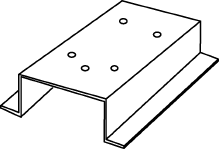
5
The scanner unit should be mounted on the center line of your vessel in
a location that has an unobstructed view forward and is as clear as pos-
sible the rest of the way around the unit.
A location as high as practical to improve maximum range is desirable,
keeping in mind that minimum range objects may be overlooked if
mounted too high.
Position the unit forward of large structures and exhaust stacks. Large
structures or stacks cause blind spots. Contamination from engine ex-
haust on the scanner housing also reduces radar performance.
Antennas for GPS, radio communication or other equipment should not
be in the radar beam. Use non-metallic extension poles to move the ac-
tive area of antennas above the radar beam.
In selecting a location, consider the suitability of the mounting surface.
It must be flat and approximately level with the vessel’s water line. The
surface must support the weight of the scanner and have access to the
underside for installation of the four mounting bolts. (Weights are
listed in the specifications table in the back of this manual.)
Obtaining sufficient dip angle
Raise the scanner position so that there is a sufficient dip angle avail-
able between the line of sight from the scanner to the obstacle and the
horizontal line. By raising the dip angle above 5°, it is possible to pre-
vent mid- and long-distance shadow zones. The radar cannot detect ob-
jects below the line of sight.
Mounting Base
Use a mounting base such as the one shown below, or you can install
the scanner directly to a roof or other flat surface. Make sure you keep
the water drain tube clear. It's located at the bottom of the scanner
unit.
Note: If the mounting bracket or surface has a curvature of more than
2 mm, use spacers with the mounting bolts to prevent stress on the
scanner housing.
Mounting base for radar scanner unit.


















